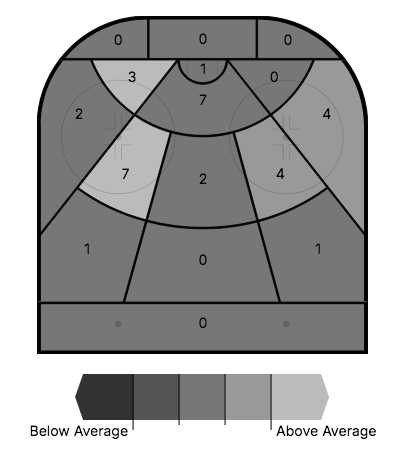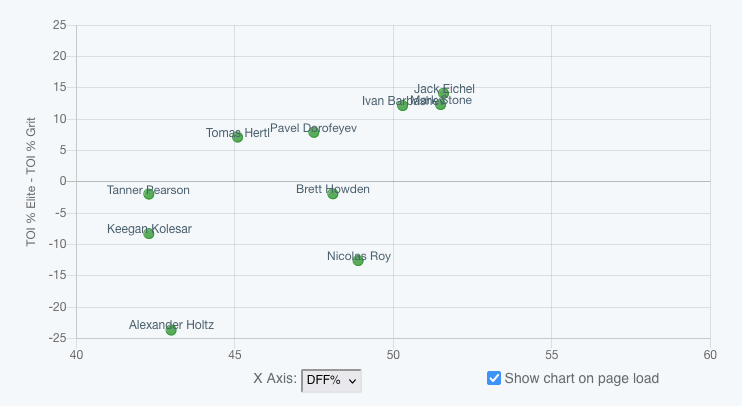
From managerial nightmare to head coach’s dream, Jack Eichel has authored a sensational career turnaround in Vegas.
And he’s not done yet. His new full-time partnership with perennial Selke Trophy candidate Mark Stone and world-class grinder Ivan Barbashev (178 minutes as trio last season) has raised his ceiling and produced one of the most fearsome lines in hockey.
Here’s why Eichel is knocking on the door of “top 5 center” status.
Dual Threat
The 2015 second overall pick possesses a rare blend of size (6’2”, 206 lbs), blinding speed (99th percentile) and top-flight skill. Each of these components is shining brighter than ever in 2024-25. He looks faster while screaming through the NZ. He looks more composed with defenders draped over his back. And perhaps most importantly, he looks as deceptive as ever with the puck on a string.
Defenders are having trouble corralling Eichel because he no longer fits neatly into one box. Is he still first and foremost a playmaker? Absolutely. His vision and accuracy are excellent. Crafty angles. He works the cross seam really well on the PP too.
However, he doesn’t insist on distributing the puck at all costs. He’s grown comfortable with accepting the best design available to his team, which makes him (VGK 9) quite a tricky cover:
10 years in, Eichel is learning to weaponize his playmaking in order to carve out prime shooting opportunities for himself. Cheat on the pass, and he’ll consume every inch of good ice you grant him before bombing on your goaltender.
On the rush, he’s taken his shot-pass recalibration a step further by developing a taste for new-school power hockey. He complements his long reach and long speed with the occasional shoulder dip and net drive. There’s a touch of heft hidden beneath the finesse, and this more direct tack blind-sides defenders who expect him to stop and scan or circle the cage.
There’s a difference between reluctant and selective shooters. Given the 28-year-old’s skill set and instant chemistry with another dual threat (Stone), Eichel can afford to wait for his Grade A chances.
It’s not as though they’ve been scarce:

Thanks to his OZ balance, Eichel has an answer for any obstacle he encounters. Consider the following examples:
Off a quick up in transition, Eichel cuts inside on his forehand. Calgary aims to snuff the danger out ASAP, throwing two forwards (CGY 58 and 11) as well as a blueliner (Kevin Bahl, CGY 7) at him in hopes of eating his time and space. Although this maze of bodies does stop him from accessing the guts of the ice…it also reveals weaknesses elsewhere.
Puck-watching against a passer of this caliber is madness. Eichel lures the Flames into his trap and hits the trailer (Brett Howden, VGK 21) for a slot opportunity.
At the same time, you can’t sag off and pray that he forces a pass into congestion:
After a nifty link-up pass by Barbashev (VGK 49) in the NZ, Eichel swings over Stone (VGK 61) to outnumber Vladislav Gavrikov (LA 84) and command the puck on the left flank. Stone obliges, and in an effort to maintain their positional discipline, the Kings leave Vegas’ 1C alone vs. Gavrikov.
Since the blueliner can’t gap up on entry and Stone is running a soft pick, Eichel enjoys a clear path to prime real estate.
Pulling the trigger may not be his first instinct, but he’s happy to challenge goaltenders himself when it’s the optimal choice. His well-rounded munitions (hot-knife-through-butter transition game, ability to thread the needle, willingness to shoot and flashes of net drive) have yielded 19 points in 13 games to open the campaign. His PPG is tied for 10th in the league and his points/60 have skyrocketed:
If you’re counting on Eichel’s 17.8 OISH% to normalize as the year progresses, it could be a while. He, Stone and Barbashev converted their chances at a scintillating 20% clip in 2023-24. They may well have the Midas touch.
Puck Protection
Even when he isn’t lighting up the score sheet, his play with the puck tenderizes the opposition, resulting in smoother sailing for the Golden Knights. He’s blossomed into a monster in possession, capitalizing on his range, strength and dexterity to play keepaway vs. helpless defenders.
While collisions are inevitable in 50/50 battles, they’re an afterthought to Eichel. He chooses to engage stick first, digging underneath defenders’ leverage to call dibs on the biscuit. That split-second upper hand at the point of attack, in concert with his wingspan, supplies the Golden Knights with countless mini-victories in the trenches.
Once he grabs the puck, he aims to establish a healthy cushion from the boards. Some wiggle room to either absorb contact or uncover an escape route. No easy pins for defenders:
The most impressive aspect of his puck protection is how seamlessly he flows from playing low to playing long. When bracing for impact, the lanky center turns into a compact and almost immovable tank. When he has more space to operate in, he holds the puck far outside his frame and leans in with his opposite shoulder/forearm to wield a wedge block of sorts. The distance he can create between his blade and his counterpart is staggering.
Watch him toy with Fabian Zetterlund (SJ 20):
This sequence begins with Zach Whitecloud (VGK 2) chucking the puck into traffic. The moment Eichel spots it at his feet, he squats to enter a three-point stance that prevents Zetterlund from disrupting his initial touch.
From there, he goes 10-and-2 behind the cage for a wider view of the slot. Nothing cooking. Shielding the puck at the end of his range, he slams on the brakes and feels the Sharks forward overcorrect to his movement. One quick shift back to the forehand and he’s generated an ocean of separation.
OK, how about against a proper defender?
As Eichel attempts to receive a pass that falls short in transition, 6’3”, 212-pound rearguard Mikhail Sergachev (UTA 98) wants to lower the boom. Eichel goes shoulder to shoulder to shrug off his opponent and secure possession. Notice how Sergachev—technically the bigger man—just bounces off him when he posts up on second contact.
Recognizing that Nick Schmaltz (UTA 8) is ready to bracket him over his left shoulder, he climbs toward the blue line with the puck extended to buy time for reinforcements. Broken play in the NZ —> uncontested possession in the OZ.
You could argue that the most important facet of Aleksander Barkov’s defense is actually his knack for possession. Eichel isn’t Sasha’s equal in this domain, but his impact resides in the same ballpark. Keeping teams buried in their zone is how you silence their attack. How you wear on them over the long haul.
They can barely mount an offensive during his TOI:
Eichel’s confidence down low is sky high right now. He doesn’t believe anyone can take the puck from him. Considering the early returns, it’s tough to claim otherwise.
Defense
No, he’s not a Selke-caliber center. Yes, he’s benefiting from Stone’s presence on his line.
With that out of the way, Eichel’s defense deserves a shout as well. He’s become much more engaged in the NZ and DZ over the past couple of years, reminding himself to churn those legs on the backcheck and close the distance on puck-carriers. He’s rangy and disruptive. He digs in and competes:
It’s not always textbook, but he’s in the foxhole with his teammates. That’s more than many 1Cs can say.
Eichel’s off-puck anticipation is particularly sharp in the NZ. He lays in the weeds, reads off his F1’s pressure and adjusts his angle to pounce on the likeliest breakout pass. In pursuit, his twig stays busy, harrying puck-carriers as he shepherds them into the arms of Vegas’ imposing blue line. His reach and skating enable him to bring transition to a screeching halt.
Here’s Eichel’s backchecking in action vs. the Kings:
Clocking his teammate’s turnover, the center puts his head down and sprints back from the OZ hashes on an aggressive line (leans strong side) to wrestle as much depth as possible before L.A. can spring its 3-on-2 attack. He peeks weak side to assess the situation, sorts out assignments with Whitecloud and slides his left skate up to shut his defensive triangle. Royal road denied.
Now for his spy games. Watch Eichel bait former Golden Knight Brayden Pachal (CGY 94) into the hockey equivalent of a pick-six:
With Barbashev applying pressure up the wall and no Flame outside the dot lane, Eichel senses that Pachal may try his luck inside. The forward hugs the boards to present a window in the heart of the NZ and then bursts into the frame at the last second, snatching the pass, delaying east-west to let Barbashev get onside and then driving north to occupy Joel Hanley (CGY 44). High-slot blast for Stone on a silver platter.
It should be apparent by now that his finest work occurs in space, where his length can cordon off huge chunks of the ice surface. He’s not as suffocating in the DZ, conserving energy in the event that Vegas flips possession. Alongside a wrecking ball (Barbashev) and the league’s preeminent thief (Stone), containment usually does the trick.
Bruce Cassidy is so pleased with Eichel’s performance that he’s feeding him heavy two-way responsibilities. Through 13 games, he leads Golden Knights forwards in short-handed TOI and faces the stiffest competition at 5-on-5:

And yet the Golden Knights own two-thirds of the goals when he’s on the ice.
Much like Eichel himself, his line shape-shifts to provide Vegas with the winning ingredients on any given night. They can tilt the ice, they can weather the storm, they can burn you on the counter. Power on power is a scary proposition against a trio that can chart multiple paths to a knockout.
We determined years ago that Eichel isn’t really Connor McDavid’s rival. Perhaps he was never meant to be.
The 28-year-old has found his home in Vegas as an elite *ahem* Jack of all trades rather than an offensive supernova. He’s the total package, and his versatility has propelled the Golden Knights to a Pacific Division-leading 9-3-1 record.



